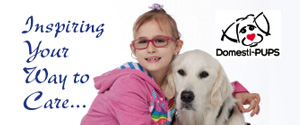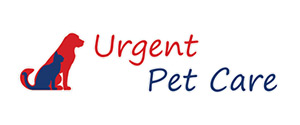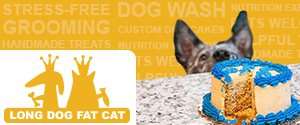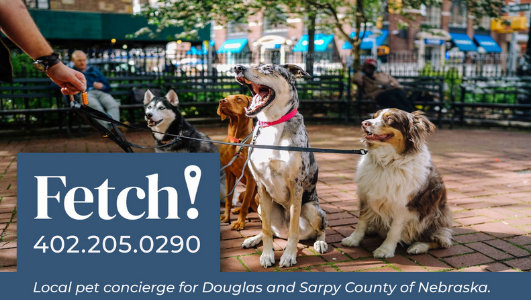- Do you subscribe to Dharma Dog Training’s Newsletter? You should.
- A Unique Campaign from The Humane Society of the United States
- Rabid bats in Omaha- Stay safe, prepared with these tips
- Springtime Activities in Omaha
- Mill Dog Monthly from Bailing Out Benji
- World Spay Day, Legislative Alert in Nebraska
- Attend the Nebraska Rescue Council’s monthly meeting this Saturday
- Five Hard-to-Ignore Reasons to Adopt!
- Paws in Pink to Benefit Breast Cancer Foundation
- VCA, Inc. Acquires MidWest Vet Specialists from Kansas State University
How Your Pet is Trying to Communicate with You

Have you ever wondered what your pet is trying to say to you when they wag their tail or have a conversation with you? Dogs and cats have different ways of communicating, of course, and many pet owners want to be able to interpret their pet’s special language.
Dogs and cats communicate through body language and vocalization. Dogs use their tail, face, eyes, and other gestures. Barking is their way of speaking. One way a cat expresses themselves is by purring. Felines also have different meows with various meanings. All pets talk to their owners.
Posture is also a factor in pet communication. In this article, you will learn more about how our dogs and cats chat with us and what they are trying to tell us by their body positions and postures.
How Your Dog Communicates with You
From the loudest bark to the meekest whimper, all dogs communicate differently; verbal and non-verbal communication is essential. Some of the ways your dog demonstrates to you what they are feeling:
Barking
According to The American Kennel Club, barking could be a friendly greeting or a warning to an intruder. Dogs vary the pitch of their barks to indicate one thing or another. The following includes some examples of what dog barks can mean:
- Yelping or rising tone Lonely and requesting companionship
- A long string of barks Alarm barking, telling the owner something is wrong
- Higher-pitched bark Generally positive and enjoying playtime, non-threatening
- Low-pitched bark Warning away an intruder wants to be left alone, threatening
When your dog is barking, match the bark with the situation. For example, if you just came home from work, and your dog displays a high-pitched bark, it is positive. They are happy to see you and may want to play.
Tail Language
If your dog’s tail is wagging fast, it usually means they are excited or happy. However, a super-fast, twitchy tail could indicate stress or anxiety. A slower wagging tail may mean your pup is exercising caution. If the tail is stiff or high in the air, it may be a sign that your dog is on high alert. The American Kennel Club says that tail wagging to the right is a positive sign, and tail wagging to the left is negative.
Facial Expression
Everyone has heard the expression, “sad puppy dog eyes. Your precious pup may put on a sweet, sad face when they know you are leaving them for the day or if you said “no” to a food or a treat. You can be sure your dog is smiling if their ears are forward and relaxed and their adorable slobbery tongue sticks out. Teeth bared means fear or aggression.
How Your Cat Communicates with You
The soft, soothing purr of a furry feline is one of the most beautiful ways cats communicate. Cats also have different meows they emote when they are expressing themselves. Some meows are more dramatic than others. Some of the ways your cat illustrates their emotions:
Meowing
The Humane Society explains that meowing is an “all-purpose” form of a cat’s communication. Meows can be used as a greeting or a stern demand to their human parent. Your cat may also be making an announcement. The following includes some examples of what cat meows can mean:
- High-pitched meow: Startled or hurt in some way
- Low-pitched meow: Unhappy, stressed or anxious
- Passionate meow: Important announcement or demand
- Repeated short meows: Happy greeting, excited to see you
Just like with dogs, you should consider the circumstances in which your cat is meowing. If it is past their dinnertime and they are standing in the kitchen crying incessantly, they are likely hungry. Sometimes cats meow just because they want to tell you about their day.
Tail Language
A cat’s tail up in the air in the shape of a question mark means they feel confident, happy and may want to play. When a cat’s tail is up and bushy, and their back is arched, it is a pose called “Halloween cat.” It generally occurs when a cat feels scared. A cat whose tail is thumping back and forth on the ground means they are agitated or upset.
Purring and Hissing
Purrs often occur when a cat is feeling good. Maybe you are petting them, or they are content in your lap and loving life. Some cats even purr when they are eating because it makes them happy. Sometimes, a cat will purr when they are anxious or sick as a way to soothe themselves. Hissing means your cat needs to be left alone. They may be feeling aggressive and have had enough petting or attention.
Kneading (Biscuit Making)
Kneading, or “biscuit making,” looks like they are kneading bread dough. It is a neat thing that cats do to signify that they feel like you are their mommy. It is a behavior they learned when they were babies nursing. They often do this when you are giving them immense pleasure by petting them.
Conclusion
There are many ways your dog or cat communicates with you. Please pay attention to your furry friend’s speech and how they hold their bodies. From vocalization to body language, pets use their unique communication skills to tell you what they think and feel.
Latest News
-
Join Us at Pick A Pooch 2025: A Fun-Filled Weekend for the Whole Family
A Fun-Filled Weekend for Pet Lovers and Families Alike Mark...
- Posted 1 year ago
- 0
-
Beardmore Presenting Sponsor At This Years Pick-A-Pooch event
🐾 We are thrilled to announce that Beardmore Subaru is...
- Posted 1 month ago
- 0
-
How Having A Pet Can Change Your Life
Having a pet can open your heart in ways that...
- Posted 3 months ago
- 0
-
How To Improve The Life Of Your Senior Pet
Do you have an elderly fur baby and want to...
- Posted 3 months ago
- 0
-
Springtime Activities To Enjoy With Your Furry Friends
Are you preparing for warmer weather and want some ideas...
- Posted 4 months ago
- 0
-
Pros And Cons Of Microchipping Your Pets
Have you considered whether your pets should be microchipped and...
- Posted 5 months ago
- 0
-
The Best New Fun Toys For Dogs And Cats
The Best New Fun Toys For Dogs And Cats Did...
- Posted 5 months ago
- 0
-
Heartfelt Ways To Show Your Pet You Love Them
Did you know there are more ways to show your...
- Posted 6 months ago
- 0



















You must be logged in to post a comment Login